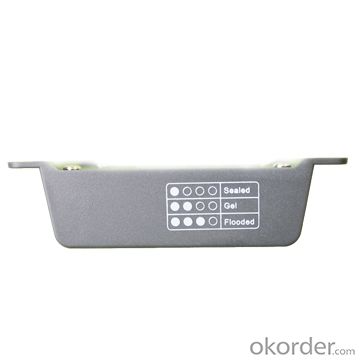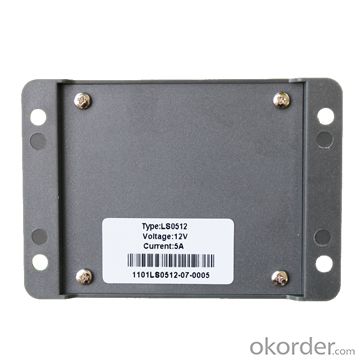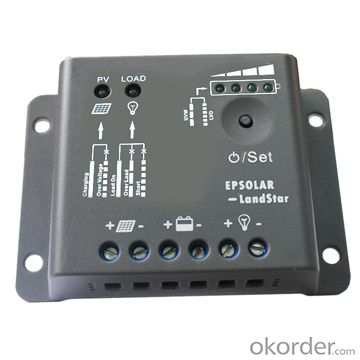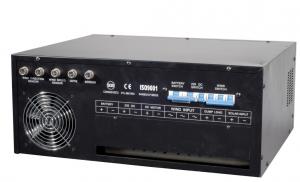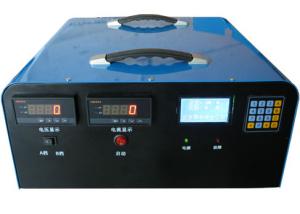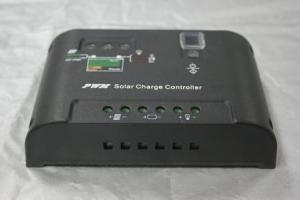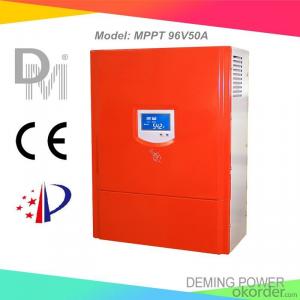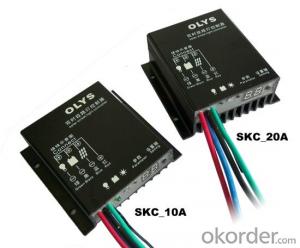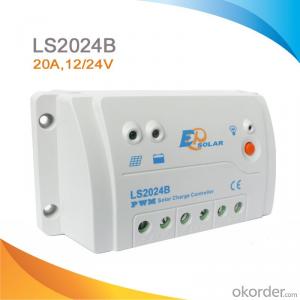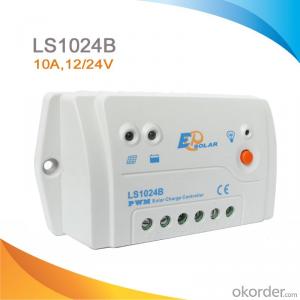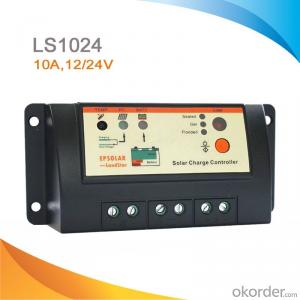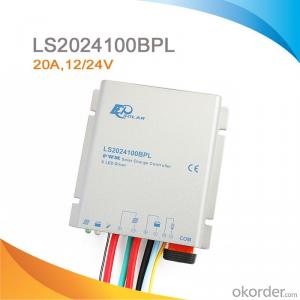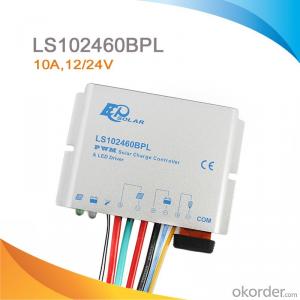PWM Solar Charge Controller 5A,12V,LS0512
- Loading Port:
- China main port
- Payment Terms:
- TT or LC
- Min Order Qty:
- -
- Supply Capability:
- -
OKorder Service Pledge
OKorder Financial Service
You Might Also Like
Features:
·High efficient Series PWM charging
·Battery type option
·LED indicators indicate battery voltage state
·Use MOSFET as electronic switch
·Temperature compensation
·Electronic protection: over charging, over discharging, overload, and short circuit
·Battery reverse polarity protection
Electronic Protections:
·Load overload
·Load short circuit
·Battery reverse polarity
Specification:
Electrical parameters | LS0512 |
Nominal System Voltage | 12VDC |
Rated Battery Current | 5A |
Max. Battery Voltage | 16V |
Charge Circuit Voltage Drop | ≤0.26V |
Discharge Circuit Voltage Drop | ≤0.15V |
Self-consumption | ≤6mA |
Overall dimension | 97 x 66x 25mm |
Terminal | 2.5mm2 |
Net weight | 0.05kg |
Working temperature | -35℃ to +55℃ |
Humidity | 10%-90% NC |
Enclosure | IP30 |
Battery Voltage Parameters (temperature at 25℃) | |||
Battery charging setting | Gel | Sealed | Flooded |
Equalize Charging Voltage | —— | 14.6V | 14.8V |
Boost Charging Voltage | 14.2V | 14.4V | 14.6V |
Float Charging Voltage | 13.8V | 13.8V | 13.8V |
Low Voltage Reconnect Voltage | 12.6V | 12.6V | 12.6V |
Low Voltage Disconnect Voltage | 11.1V | 11.1V | 11.1V |
Equalize Duration | —— | 2 hours | 2 hours |
Boost Duration | 2 hours | 2 hours | 2 hours |
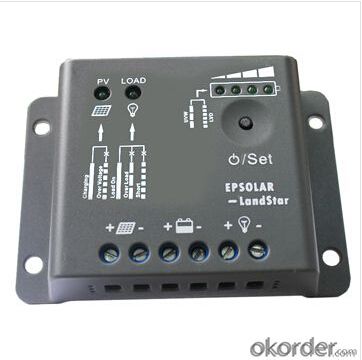
FAQ:
Q1. What is the voltage?
A1. Our 45/60A solar charge controller is 12/24/36/48V auto work.
Q2. What is the difference between MPPT&PWM?
A2. MPPT has higher efficiency, it can track the max power point and won't waste energy.
Q3. What is the efficiency of the MPPT controller?
A3. MPPT>99%, peak conversion efficiency>98%.
Q4. What is the waranty of product?
A4. 12 months.
Q5. What protection does your MPPT controller have?
A5. PV array short circuit, PV reverse polarity, Battery reverse polarity, Over charging, Output short circuit.
- Q: How does a solar controller prevent damage from reverse current flow in the load?
- A solar controller prevents damage from reverse current flow in the load by using a built-in blocking diode. This diode only allows current to flow in one direction, preventing any backflow of current from the load to the solar panels. By blocking the reverse current, the solar controller ensures that the load receives power from the solar panels without any risk of damage.
- Q: Can a solar controller be used with a solar-powered restaurant or cafe?
- Yes, a solar controller can definitely be used with a solar-powered restaurant or cafe. A solar controller helps regulate and optimize the charging and discharging of batteries in a solar power system. It ensures that the solar panels are efficiently converting sunlight into electricity and that the batteries are properly charged and protected. This is crucial for a solar-powered restaurant or cafe as it allows for a reliable and sustainable energy source to power various electrical appliances and equipment, reducing dependence on the grid and minimizing operating costs.
- Q: How does a solar controller handle overvoltage protection?
- A solar controller handles overvoltage protection by monitoring the voltage level of the solar panels or batteries connected to it. If the voltage exceeds a certain threshold, the controller automatically shuts off the charging process to prevent damage to the batteries or other connected devices. This protection mechanism ensures that the system operates within safe voltage limits and extends the lifespan of the equipment.
- Q: What is the maximum number of charging stages supported by a solar controller?
- The maximum number of charging stages supported by a solar controller can vary depending on the specific model and manufacturer. However, it is common for solar controllers to support up to three charging stages, which typically include bulk charging, absorption charging, and float charging.
- Q: Can a solar controller be used with solar-powered water heaters?
- Yes, a solar controller can be used with solar-powered water heaters. A solar controller helps regulate the flow of energy from the solar panels to the water heater, ensuring optimal performance and efficiency. It helps monitor and control the temperature and pressure of the system, preventing overheating or damage. Overall, a solar controller is an essential component in maximizing the effectiveness of solar-powered water heaters.
- Q: How do you determine the appropriate size of a solar controller for your system?
- To determine the appropriate size of a solar controller for your system, you need to consider the maximum current and voltage rating of your solar panels. The solar controller should have a current and voltage rating that can handle the maximum capacity of your panels without causing any damage. It is also important to consider the load or appliances connected to the solar system and ensure that the controller can handle the power requirements of those devices. Additionally, factors like the system's temperature range, efficiency, and any future expansion plans should be taken into account when selecting the appropriate size of a solar controller.
- Q: What are the indicators and displays on a solar controller for?
- The inclusion of indicators and displays in a solar controller is crucial for the monitoring and management of a solar power system. These features offer valuable insights into the functioning and status of both the solar controller and the overall solar energy system. The main objective of these indicators and displays is to provide real-time information regarding the charging and discharging of the batteries that are connected to the solar system. This information encompasses battery voltage, current, state of charge (SOC), and battery temperature. By keeping an eye on these indicators, users can evaluate the condition and performance of their batteries and take appropriate action if any issues arise. Moreover, these indicators and displays often present data on the output of the solar panels, including the current generated, the voltage produced, and the overall power generation. This allows users to monitor the efficiency and effectiveness of their solar panels and make adjustments as necessary. Furthermore, certain solar controllers come equipped with built-in data logging capabilities, enabling users to track historical data on energy production, battery performance, and other pertinent metrics. This data can be utilized for analysis, troubleshooting, and optimizing the performance of the solar power system. In addition, indicators and displays on a solar controller can issue alerts and notifications for various conditions, such as low battery voltage, overcharging, or overheating. These warnings help users identify potential problems and take prompt action to prevent any damage to the system or ensure its optimal performance. All in all, the indicators and displays on a solar controller function as a comprehensive monitoring and control system for solar power systems, providing crucial information on battery status, solar panel performance, and system health. Armed with this information, users can make well-informed decisions, maximize energy efficiency, and ensure the longevity of their solar power system.
- Q: Can a solar controller be used with solar-powered greenhouse ventilation systems?
- Yes, a solar controller can be used with solar-powered greenhouse ventilation systems. A solar controller is designed to regulate the charging and discharging of batteries in solar systems, and in the case of a solar-powered greenhouse ventilation system, it can be utilized to control the powering and operation of the ventilation system based on the available solar energy.
- Q: What is the maximum load voltage a solar controller can handle?
- The maximum load voltage a solar controller can handle depends on the specific model and its specifications. It is recommended to consult the manufacturer's guidelines or the product manual to determine the maximum load voltage capacity of a particular solar controller.
- Q: Can a solar controller be used with solar-powered street lights?
- Yes, a solar controller can be used with solar-powered street lights. The solar controller is essential for regulating and managing the flow of electricity from the solar panels to the street lights. It ensures that the batteries are properly charged and prevents overcharging or discharging, maximizing the efficiency and lifespan of the street lights.
Send your message to us
PWM Solar Charge Controller 5A,12V,LS0512
- Loading Port:
- China main port
- Payment Terms:
- TT or LC
- Min Order Qty:
- -
- Supply Capability:
- -
OKorder Service Pledge
OKorder Financial Service
Similar products
Hot products
Hot Searches
Related keywords





